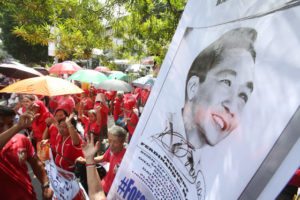TWO JUSTICES of the Supreme Court on Wednesday challenged the petitioners seeking to stop the burial of former President Ferdinand Marcos at the Libingan ng mga Bayani, pointing out there are no clear rules on who should be buried in the military-owned cemetery.
Even wives of former secretaries of Defense are buried at the Libingan, contrary to the position of the anti-Marcos petitioners that only “heroes” should be buried there, Associate Justice Teresita Leonardo-de Castro said during oral arguments on six consolidated petitions against the internment.
“[S]pouses of Secretaries of National Defense are allowed to be buried there. Are they heroes? Can we say there are guidelines? There’s not even a body which will determine who are heroes, who should avail [themselves] of this privilege to be buried in the Libingan ng mga Bayani. Is the Court the one to determine, in the absence of any guidelines [on] who are the bayani (heroes)?” de Castro said.
She was questioning defeated senatorial candidate Neri Colmenares, one of the human rights victims during the Marcos regime questioning the Duterte administration’s approval of the burial of the late strongman at the Libingan in Taguig.
“You have to explain what is meant by ‘bayani’ … based on existing rules, laws and regulations pertaining to this cemetery in Fort McKinley, now Fort Bonifacio, because there seems to be no established guidelines as to who are heroes, as to who are disqualified [to be buried in that cemetery],” de Castro said.
She also challenged the petitioners to prove their argument that the Libingan is the same as the “National Pantheon for Presidents of the Philippines, National Heroes and Patriots of the Country” ordered built by Republic Act (RA) 289.
“[O]r is it just a war memorial for which it was originally created?” she asked.
Will of the people
Associate Justice Jose Perez likewise pointed out that RA 289 does not provide guidelines on who are “worthy of public emulation and inspiration.”
Petitioners, he noted, seem to want the high tribunal to bear the responsibility of proclaiming Marcos as not deserving of national esteem and therefore not worthy of burial at the Libingan, rather than leave it to the people.
Perez said President Rodrigo Duterte’s 16 million votes during the polls implies ratification or public approval, which empowers him to decide on the burial of Marcos.
During the campaign, Duterte, whose father served as a Cabinet official under Marcos, repeatedly said he would bury the late strongman at the military cemetery.
“Is that not a decision of the sovereign people themselves? And what the electorate voted in favor of, we will now nullify? Can you not say that it was the electorate, the sovereign people, who favor the burial [at the Libingan]?” Perez asked.
‘Not worthy’
The petitioners, mostly Martial Law victims, focused on the argument that Marcos should not be given honors because he is considered a dictator.
“A dictator responsible for countless human rights violations does not deserve a place in the pantheon. The dishonored cannot join the honored; Marcos is not worthy of emulation and inspiration,” Colmenares said.
The former party-list congressman said Marcos should never be buried on publicly owned land.
Albay Rep. Edcel Lagman, whose brother Hermon disappeared during Martial Law and was never found, said “far from being a hero, former President Ferdinand Marcos was a despot, an oppressor of the Filipino people, during the dark era of Martial Law.”
“A Marcos hero’s burial would glorify a dictator, distort history, aggravate the injustice to human rights violation victims and their families and mock the heroism of desaparecidos (disappeared) and other victims of Marcos’ atrocities,” Lagman added.
Bound by statutes
Barry Guttierez, who represented Martial Law victims like former Commission on Human Rights (CHR) chairwoman Loretta Ann Rosales, said Duterte was constitutionally bound by statutes that recognize the Marcos regime’s atrocities, such as Republic Act 10368 that gave reparations to human rights victims.
Rosales and other victims, including Nilda Lagman-Sevilla, Ma. Cristina Rodriguez, Fe Mangahas, Hilda Narciso and Ma. Cristina Bawagan, took turns telling their stories.
CHR Chairman Jose Luis Martin Gascon said domestic and international laws impose upon the government the obligation of “non-repetition,” and Marcos’ burial at the Libingan would expose victims to “re-traumatization.”
Penciled by Imelda
Close to the end of the oral arguments, former Interior secretary Rafael Alunan was summoned to read the agreement he had reached, on behalf of the Ramos administration, with the Marcoses on the return of the former President’s remains from Hawaii in 1993.
Chief Presidential Legal Counsel Salvador Panelo had said the agreement, in which Marcos was to be buried in his home province of Ilocos Norte, was no longer binding.
Alunan said the fourth paragraph of the memorandum of agreement was controversial because former first lady Imelda Marcos penciled the words “temporarily interred” on the document to replace “buried on the 9th of Sept.”
Alunan said Mrs. Marcos countersigned it but he did not.
Chief Justice Maria Lourdes Sereno ordered the Solicitor General to request an original of the agreement from former President Fidel Ramos.
Sereno adjourned the oral arguments and called for another session at 10 a.m. on September 7.


